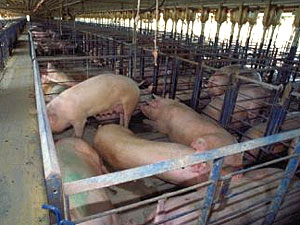
Agricultural News
New CAST Commentary Examines the Connections between Animal Health and Food Safety
Tue, 08 May 2012 22:42:46 CDT

Many groups in society, including politicians, activists, scientists, and stakeholders, are advocating significant changes to livestock production practices. These changes include modification of stocking densities, limitations on antimicrobial use, and requirements for outdoor "experiences."
Such changes may indeed affect animal health, but not always for the better according to a new commentary by the Council for Agricultural Science and Technology (CAST) in Ames, Iowa. It calls on those clamoring for change to understand the complex relationship between animal health and food safety before mandating changes that may undermine a safe food supply.
The commentary looks at the pressures to change livestock rearing methods, evidence to support the direct public health impact on human illness days, and food safety and inspection service regulations. The authors use indirect evidence, diagrams, and graphs to deliver their findings about the ways that healthy animals result in safer food.
The commentary's authors illustrate how healthier animals do result in healthier food and healthier humans. They go on to examine certain husbandry practices which have been altered recently due to government or market place perceptions and pressures. They finally ask if these changes have increased human health or have decreased it.
The commentary cites one particularly appropriate issue the world over: animal housing. The European Union has severely curtailed the use of disease-preventive antibiotics in food-animal production and has begun to legislate how animals are housed (e.g., banning of confinement housing such as gestation stalls for pigs). Subsequent to these bans, treatment of pigs for clinical disease has reportedly increased in Denmark and the Netherlands.
A second area of concern is the health impact of organic production. In many cases animal products sold with the organic designation must not be treated with antibiotics or synthetic anthelmintic (worm-preventing) drugs. Additionally, organic production may mean "natural" or pasture-based rearing. When coupled with animal welfare concerns, significant housing changes might impact animal health. For example, increased exposure to the soil and vermin may increase the prevalence of zoonotic diseases in livestock.
The impacts are not always readily apparent to the naked eye and must be carefully studied the commentary said.
"There is a growing body of evidence showing that chronically, previously, and not visibly ill animals are more likely to be contaminated with foodborne pathogens after processing in the abattoir (slaughterhouse). These animals, however, may go unnoticed during antemortem (live animal) inspection, and thus questions arise concerning the potential impacts of these animals entering the food supply on public health risk from foodborne pathogens."
The study says that opposition to modern husbandry practices, housing strategies and bio-security measures while well-intentioned, may not promote animal health. Such practices were designed primarily to decrease livestock diseases and improve productive efficiency and may also inherently lower the prevalence of foodborne pathogens.
As an example, the study cites research examining the maintenance of animals on slatted or mesh floors, as is common in modern swine production and some poultry systems. It decreases animal contact with manure and thus with fecalborne pathogens. Internal parasite loads also are decreased with the use of slatted or mesh floors. Citations were given showing swine held in abattoirs (two to four hours) on slatted floors had a lower prevalence of Salmonella compared with swine maintained on solid floors for the same period of time.
"The continued questions by many stakeholders concerning the present intensive housing systems for food production animals that have been developed to maximize animal health and improve efficiencies of production must not be overlooked. The move to less restrictive housing systems for food production animals in countries such as those in the European Union will no doubt influence husbandry practices in the United States.
"For example, the recent move by some retailers to start sourcing poultry products from cage-free systems and pork from swine operations that do not use gestation stalls must be considered, because poorly managed, less restrictive systems can have dramatic impacts on animal health. For improvements in animal health to be adopted, however, they must also be sustainable. For example, improvements in one aspect of the production system such as health must not come at the expense of another (e.g., animal welfare)."
The commentary's authors found that there was much more research that needed to be done to make sound decisions that affect animal health and, ultimately, the health of the consumer.
"We see much need for research to identify sustainable food animal production practices that protect human health but also are sustainable in terms of public expectations."
Click here to read the full commentary.
WebReadyTM Powered by WireReady® NSI
Top Agricultural News
More Headlines...



















